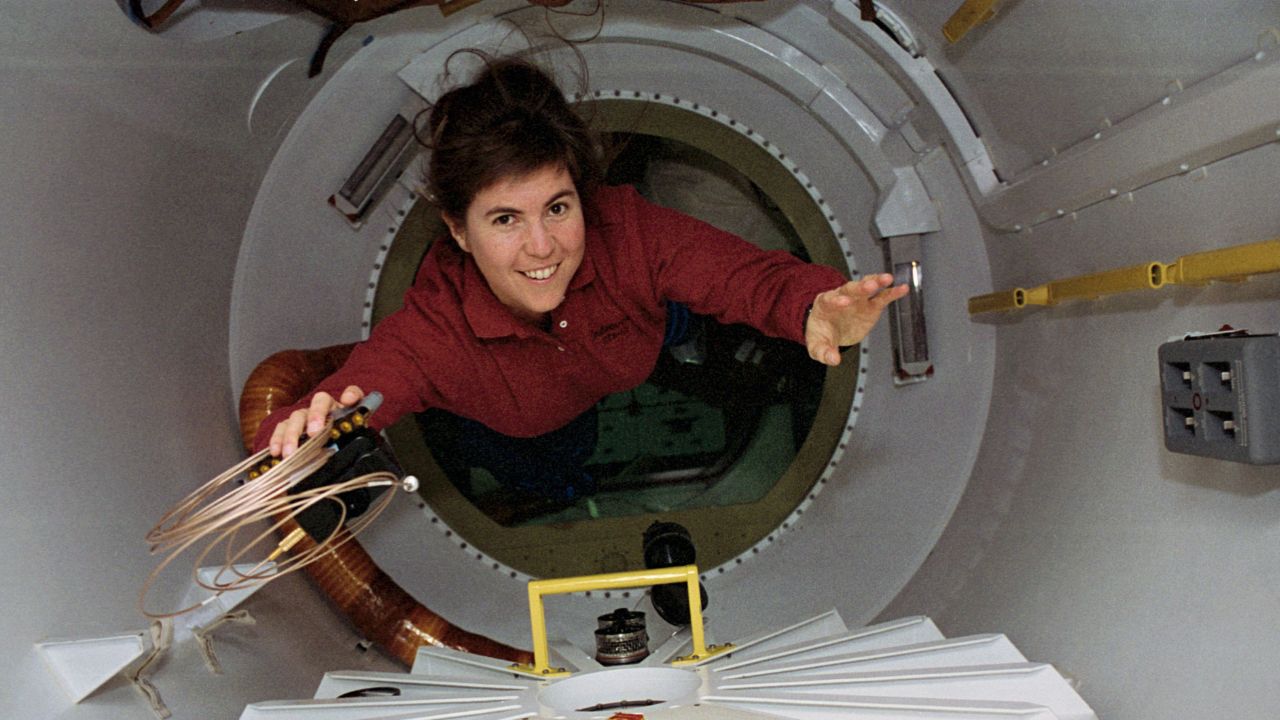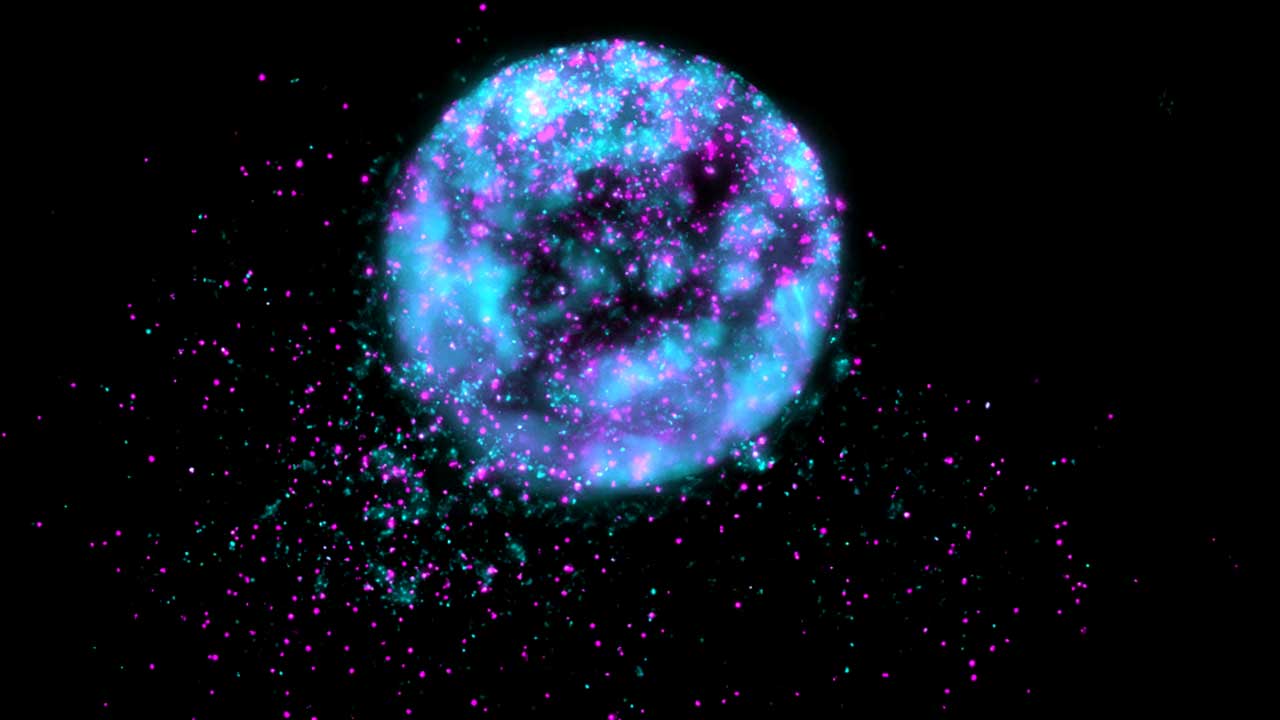Innovation in Focus: Hope Beyond Gravity

NASA astronaut Janice E. Voss, mission specialist, floated through a special tunnel into the SpaceHab module, circa 1993.
Media Credit: NASA
Pioneering breakthroughs in cancer treatment through ISS National Lab-sponsored research
October 29, 2025 • By Amy Elkavich, Staff Writer
Cancer is the second leading cause of death in the United States, and breast cancer is the most common cancer among women, affecting millions worldwide. While Earth-based research has made significant strides in advancing cancer treatment, scientists look to the unique environment of space to unlock new possibilities. The ISSInternational Space Station National Lab is sponsoring research at the forefront of this frontier, supporting groundbreaking studies that leverage microgravityThe condition of perceived weightlessness created when an object is in free fall, for example when an object is in orbital motion. Microgravity alters many observable phenomena within the physical and life sciences, allowing scientists to study things in ways not possible on Earth. The International Space Station provides access to a persistent microgravity environment. to better understand cancer cell behavior, tumor growth, and drug responses.
This photo essay captures the efforts to advance cancer research onboard the ISS—from the launchpad to the lab modules orbiting 250 miles above Earth. Through imagery and research, astronauts, and survivors, we explore how space-based science is accelerating the path to more effective cancer diagnostics and treatments, offering renewed hope to patients and families.
October is About Awareness

Media Credit: NASANational Aeronautics and Space Administration
Janice E. Voss was a distinguished American engineer and NASA astronaut who flew on five space shuttle missions, spending more than 49 days in orbit and contributing to valuable scientific work, including Earth mapping and international space collaboration. In 2012, Voss passed away from breast cancer at the age of 55. Born in South Bend, Indiana, she began her NASA career as a teenager and earned degrees from Purdue University and MIT. Voss was known for her technical expertise, leadership, and passion for space exploration, later serving as the science director for NASA’s Kepler mission.
Space-Grown Crystals

Comparison of space-grown (left) and Earth-grown (right) protein crystals
Media Credit: NASA
Scientists use the microgravity environment of the ISS to grow higher-quality protein crystals than is possible on Earth. These space-grown crystals are helping researchers better understand proteins related to cancer, heart and liver disease, DNA repair, and metabolic disorders—advancing drug development and disease treatment. This is just one of the ways space-based science is unlocking new possibilities for human health.
Transforming Treatment Through Microgravity

NASA astronaut Thomas Pesquet removing the Protein Crystallization Facility hardware from the incubator on the ISS for Merck's investigation.
Media Credit: NASA
Merck & Co. scientists explored how microgravity could help enhance cancer treatments like Keytruda®. Through space-based research, the company produced highly uniform protein crystals with properties that could allow Keytruda® to be given as a quick injection instead of a lengthy IV infusion. Recently, the U.S. Food and Drug Administration (FDA) approved a new injectable formulation of the drug that combines the active ingredient in Keytruda® with an enzyme. This new formulation could simplify treatment, reduce costs, and improve patient quality of life. Read more in this Upward feature.
Cancer at the Cellular Level

This 24-hour time progression of lung cancer cells treated with MicroQuin's small molecule drug shows holes forming in the endoplasmic reticulum (ER vacuolation) of the cells, with floating dead cancer cells in the final frame.
Media Credit: Microquin
Biotech startup MicroQuin is reshaping cancer research by taking it to space. Using the unique microgravity environment on the ISS, the company grew 3D cultures of breast and prostate cancer cells to better understand how cancer forms and grows. What they discovered was groundbreaking: a new way to target and kill cancer cells without harming healthy ones, potentially revolutionizing treatment for all types of cancer. Read more in this Upward story.
A Personal View from the CupolaA small module on the International Space Station with seven windows for observing and photographing Earth, spacecraft arrivals and departures, and spacewalks.

Smith's inspiration in her fight against breast cancer was her father, Dennis Williamson, who courageously fought brain cancer for 21 years.
Media Credit: Amelia Williamson Smith
ISS National Lab Science Communications Manager Amelia Williamson Smith shares how space-based cancer research on the ISS became personal after her own breast cancer diagnosis. In this Upward perspective article, she highlights groundbreaking discoveries from MicroQuin and Axonis Therapeutics, showing how microgravity enables medical breakthroughs that could revolutionize cancer treatments. It’s a powerful reminder of how science in space could help save lives on Earth.
Testing Therapies in Orbit

This microscopic image shows a cloned tumor sample from a SpaceX CRS-30 investigation that used Encapsulate’s tumor-on-a-chip system to grow patient-derived cancer cells and test chemotherapy drugs in microgravity.
Media Credit: Encapsulate
Biotech startup Encapsulate is taking personalized cancer treatment to new heights—literally. Using the company’s innovative “tumor-on-a-chip” system, the research team grew patient-derived cancer cells on the ISS that more closely resemble cancer growth on Earth. The researchers were able to test multiple chemotherapy drugs on these mini-tumors and predict the most effective treatment in just days, bypassing the trial-and-error approach that often costs patients precious time. Read all about this research in this Upward article.
Targeted Cancer Therapy

Researchers from UC San Diego are sending tumor organoids to space to better understand how cancer spreads.
Media Credit: Sanford Stem Cell Institute at the University of California San Diego
Researchers from UC San Diego’s Sanford Stem Cell Institute sent cancer organoids to the ISS for multiple projects studying cancer stem cells, which drive cancer growth. The team found that an enzyme linked to cancer spread was activated during spaceflight and tested therapies that stop the enzyme’s activity. One of the drugs tested on the ISS was recently approved by the FDA to start clinical trials. This is another strong example of how space-based science is helping improve cancer treatment on Earth.